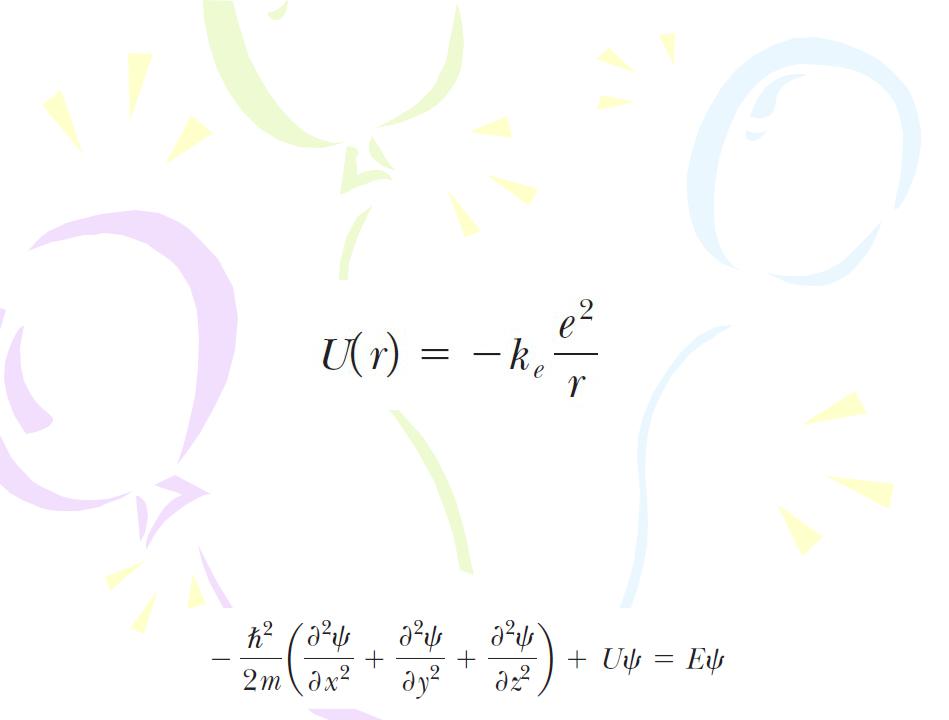
- •Course of lectures «Contemporary Physics: Part2»
- •Atomic Spectra of Gases
- •Atomic Spectra of Gases
- •Atomic Spectra of Gases
- •Atomic Spectra of Gases
- •Early Models of the Atom
- •Early Models of the Atom
- •Early Models of the Atom
- •Bohr’s Model of the Hydrogen Atom
- •Bohr’s Model of the Hydrogen Atom
- •Bohr’s Model of the Hydrogen Atom
- •Bohr’s Model of the Hydrogen Atom
- •Bohr’s Model of the Hydrogen Atom
- •Bohr’s Model of the Hydrogen Atom
- •Bohr’s Model of the Hydrogen Atom
- •Bohr’s Model of the Hydrogen Atom
- •Bohr’s Model of the Hydrogen Atom
- •Bohr’s Model of the Hydrogen Atom
- •Bohr’s Model of the Hydrogen Atom
- •The Quantum Model of the Hydrogen Atom
- •The Quantum Model of the Hydrogen Atom
- •The Quantum Model of the Hydrogen Atom
- •The Quantum Model of the Hydrogen Atom
- •The Wave Functions for Hydrogen
- •The Wave Functions for Hydrogen
- •The Wave Functions for Hydrogen

Bohr’s Model of the Hydrogen Atom
3. The atom emits radiation when the electron makes a transition from a more energetic initial stationary state to a lower-energy stationary state. This transition cannot be visualized or treated classically. In particular, the frequency f of the photon emitted in the transition is related to the change in the atom’s energy and is not equal to the frequency of the electron’s orbital motion. The frequency of the emitted radiation is found from the energy-conservation expression 
where Ei is the energy of the initial state, Ef is the energy of the final state, 

Bohr’s Model of the Hydrogen Atom
4. The size of an allowed electron orbit is determined by a condition imposed on the electron’s orbital angular momentum: the allowed orbits are those for which the electron’s orbital angular momentum about the nucleus is quantized and equal to an integral multiple of 
where me is the electron mass, v is the electron’s speed in its orbit, and r is the orbital radius.

Bohr’s Model of the Hydrogen Atom
Using these four postulates, let’s calculate the allowed energy levels and find quantitative values of the emission wavelengths of the hydrogen atom. 
the kinetic energy of the electron is

Bohr’s Model of the Hydrogen Atom
The following expression for the total energy of the atom:
The orbit with the smallest |
0, |
corresponds to n =1 and has the |
|

Bohr’s Model of the Hydrogen Atom
The quantization of orbit radii leads to energy quantization.  Substituting
Substituting 

Inserting numerical values into this expression, we find that

Bohr’s Model of the Hydrogen Atom
We can calculate the frequency of the photon emitted when the electron makes a transition from an outer orbit to an inner orbit:
Because the quantity measured experimentally is wavelength, it is convenient to use c=fλ to express this Equation in terms of wavelength:
Remarkably, this expression, which is purely theoretical, is identical to the general form of the empirical relationships discovered by Balmer and Rydberg:

Bohr’s Model of the Hydrogen Atom
Soon after Bohr demonstrated that these two quantities agree to within approximately 1%, this work was recognized as the crowning achievement of his new quantum theory of the hydrogen atom. Furthermore, Bohr showed that all the spectral series for hydrogen have a natural interpretation in his theory. The different series correspond to transitions to different final states characterized by the quantum number nf.

Bohr’s Model of the Hydrogen Atom
Bohr showed that many mysterious lines observed in the spectra of the Sun and several other stars could not be due to hydrogen but were correctly predicted by his theory if attributed to singly ionized helium. In general, the number of protons in the nucleus of an atom is called the atomic number of the element and is given the symbol Z. To describe a single electron orbiting a fixed nucleus of charge +Ze, Bohr’s theory gives

Bohr’s Model of the Hydrogen Atom
Bohr’s Correspondence Principle
 In our study of relativity, we found that Newtonian mechanics is a special case of relativistic mechanics and is usable only for speeds much less than c. Similarly,
In our study of relativity, we found that Newtonian mechanics is a special case of relativistic mechanics and is usable only for speeds much less than c. Similarly,
quantum physics agrees with classical physics when the difference between quantized levels becomes vanishingly small.
This principle, first set forth by Bohr, is called the correspondence principle.

The Quantum Model of the Hydrogen Atom
The formal procedure for solving the problem of the hydrogen atom is to substitute the appropriate potential energy function into the Schrӧdinger equation, find solutions to the equation, and apply boundary conditions. The potential energy function for the hydrogen atom is that due to the electrical interaction between the electron and the proton: 
The mathematics for the hydrogen atom is more complicated than that for the particle in a box because the atom is three- dimensional and U depends on the radial coordinate r. If the time- independent Schrцdinger equation is extended to three- dimensional rectangular coordinates, the result is
